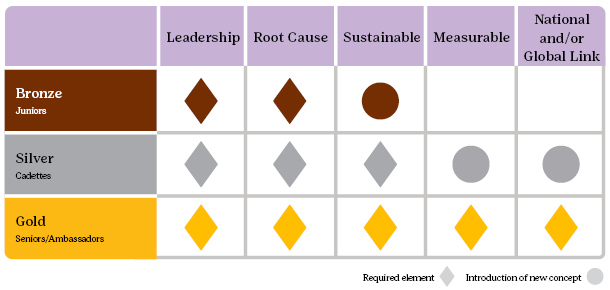
Highest Awards - FAQ
Find quick answers to your questions about Girl Scouting's Highest Awards : the Girl Scout Gold Award , Silver Award , and Bronze Award .
What are the Highest Award prerequisites? 

Why are the Leadership Awards prerequisites to earning the Girl Scout
Bronze, Silver, and Gold Awards? 

Why are Journeys prerequisites to earning the Girl Scout Bronze, Silver,
and Gold Awards? 

How do Girl Scouts know when a Journey is completed? 

What makes the guidelines for Girl Scouts’ Highest Awards different from
those for the Journeys? 

What are the suggested hours for earning each of the awards? 

Can a troop work toward an award together? 

Can Girl Scouts begin working toward their awards the summer after they
bridge (transition) from one Girl Scout level to the next? 

Can Take Action projects for the Girl Scout Bronze, Silver, and Gold
Awards focus on Girl Scouting? 

If a Girl Scout starts working on a Take Action project and moves, can
they still earn their award? 

Who are the adult guides for: council staff, parents, or volunteers? 

Do we need a different set of requirements for Girl Scouts with
disabilities to earn the Girl Scout Bronze, Silver, and Gold Awards? 

Can a troop or group work toward a Gold Award together? 

Is sustainability differentiated at each grade level? 

Who can earn the Gold Award? 

Can individually registered members, or “Juliettes,” earn the Girl Scout
Gold Award? 

How can local Girl Scout councils, caregivers, volunteers, and advisors
make sure Girl Scouts carry out high-quality projects for their highest awards? 

What is the difference between a troop/group volunteer and a Girl Scout
Gold or Silver Award project advisor? Do Girl Scouts need both? 

Why can’t a parent be a Girl Scout Gold Award project advisor? 

At what point should an Award project advisor be identified? 

What is the role of a council’s Gold Award committee? 

What does it mean to have a sustainable project? 

How does a Girl Scout measure project impact? 

What does it mean to identify a national and/or global link? 

Can a Girl Scout earn their Highest Award even if they haven’t been in
Girl Scouts very long? 

What if a Girl Scout is 18 and graduating? Can they complete their Gold
Award project when they're in college? 

What if a Girl Scout graduates high school, is 18, and doesn't have
their project completed? 

What if a Girl Scout’s project is not completed by the time of their
council’s ceremony? 


